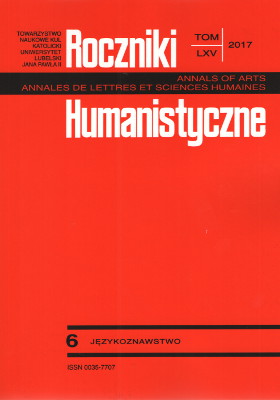Externalisierung der Flexion in der indogermanischen Ursprache
The externalization of inflection in Indo-European
Author(s): Krzysztof Tomasz WitczakSubject(s): Language and Literature Studies, Theoretical Linguistics, Morphology
Published by: Towarzystwo Naukowe KUL & Katolicki Uniwersytet Lubelski Jana Pawła II
Keywords: augment; durative verb; externalization of inflection; Indo-European morphology; long-vowel preterits; nasal infix
Summary/Abstract: The article discusses the problem of the diachronic externalization of inflection in Indo-European on the basis of (1) the externalization of the augment and (2) the externalization of the durative (nasal) morpheme. Indo-Europeanists have generally followed the traditional theory according to which the augment, i.e. the initial particle *h1e expressing past tense, represents a relatively late innovation attested in the central group of Indo-European languages. The present author demonstrates that the particle *h1e was an old morpheme originally infixed within the verbal root, e.g. PIE. *sed- ‘to sit’ (praesens) → PIE. *se-h1e-d- (praeteritum) > IE. *sēd- (past tense), cf. Lat. sedeō, perf. sēdī. The translocation of the augment from medial to initial position was probably motivated by analogy to the very frequently used verbal roots PIE. *h1es- ‘to be’, *h1ei- ‘to go’ and *h1ed- ‘to eat’, which were phonologically similar to the augment *h1e. In these roots, the original structure, namely PIE. *h1e- + (infixed augment) *h1e + -C-, was reinterpreted differently, viz. as the indeclinable augment preceding the verbal root (*h1e- + *h1eC-). By analogy, the particle *h1e started to be placed in initial position (i.e. before the verbal root) in other cases too. Intermediate (hybrid) forms of the past tense, like *h1e-me-h1e-d- (← PIE. *med-), may also be found in some Indo-European languages belonging to the central group. The Indo-European nasal infix presents have not been explained so far from the semantic point of view. The present author proves that the infix *-n- originally expressed the feature of durativity. Due to the diachronic externalization of inflection this nasal morpheme later evolved into a suffix added to the verbal root. Verba durativa with the nasal marker -an- are attested as early as in the 2nd millennium BC in the Anatolian languages, cf. Hittite iy-ann-a/i- ‘to march, to go long’, Palaic iyannnai ‘he marches (long)’ vs. Hitt. i- ‘to go’, Luw. i-, Hier. Luw. i-, Lat. eō, īre, Lith. eĩti, OChSl. iti ‘id.’ < PIE. *h1ei- ‘to go’. The durative verbs in question, as well as the related nouns with the durative suffix *-ano-, also appear in other Indo-European languages, cf. Toch. B yaneṃ ‘they walk, go long’. Numerous Greek presents (e.g. Anc. Gk. ἁνδάνω, θιγγάνω, λαμβάνω, λανθάνω, λιμπάνω, μανθάνω, πυνθάνομαι and so on) document the same nasal morpheme not only infixed into a verbal root, but also in the form of the suffix -αν-. These verbal forms, indicating the durativity of the action, should be treated as intermediate, i.e. hybrid.
Journal: Roczniki Humanistyczne
- Issue Year: 65/2017
- Issue No: 6
- Page Range: 93-109
- Page Count: 17
- Language: German

